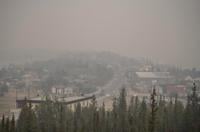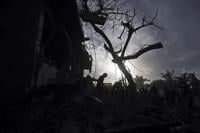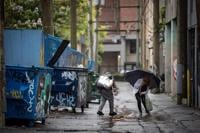YELLOWKNIFE - Firefighters trying to keep wildfires at bay from the city of Yellowknife took stock of the flames Sunday after cool, damp weather over the weekend gave them a break from the fire burning 15 kilometres from the capital.
Fire information officer Mike Westwick said crews used infrared sensors to figure out where the fire is vulnerable and what areas might be appropriate for direct attack. He added, however, the fire is so long that teams were focusing on the most critical areas.
"One of the things that's been challenging our work on this fire, in some ways, is the fact that the winds are shifting a lot," Westwick said during an online update Sunday evening, explaining that winds at the time were northerly, and were forecast to be westerly on Monday.
"That's good news in terms of progress towards Yellowknife, but it also makes us have to rethink our strategies every single day when those shift."
Yellowknife, now a deserted, smoky city, is almost completely evacuated. Only a couple thousand of the northern capital's 20,000 people remain and about half of them are emergency workers.
About four millimetres of rainfall Saturday gave firefighters a chance to build control lines on Yellowknife's western edge, and fuel breaks have been dug, and sprinkler and water systems installed.
Temperatures did rise as expected on Sunday, but Westwick described growth of the fire threatening the city as only slight.
The fire was not expected to reach the city on Monday, officials said.
A special effort was also undertaken to ensure Yellowknife's homeless population was safe.
Jennifer Young of the territory's Emergency Management Organization said homeless evacuees have been registered in the centres where they arrive, and that various mental health and addictions supports, as well as social workers, are being made available to them.
Young also said that reports that evacuees would be limited to only five days in the hotels where they're being put up are false, and that reports of widespread looting are also untrue.
On Saturday, a black bear had to be scared away from the airport, near where helicopters were taking off. Westwick said there is a chance that the flames were forcing animals out of their regular habitat.
He also said Highway 1 in the region was forced to close Sunday but it did reopen later in the day.
Meanwhile, wildfires continued to menace other communities in the territory. Only eight kilometres separated Hay River from the nearest fire, and while recent cooler weather helped limit fire growth, Westwick said a threat still remains.
Defence Minister Bill Blair tweeted Sunday afternoon that another company of soldiers was being deployed to Hay River, which has been evacuated for over a week.
Premier Caroline Cochrane said she's spoken with several federal ministers, including Prime Minister Justin Trudeau and Finance Minister Chrystia Freeland, explaining that the territory needs financial assistance to deal with the fires and help evacuees.
"This is going to be a large bill and we are going to need financial help going forward. So this is going to be a cause that I'm not letting go of," Cochrane said on Sunday night.
Planning is already underway in case the upcoming school year is disrupted, Cochrane added, noting the response could be online learning, which was done during the COVID-19 pandemic.
Environment and Climate Change Minister Shane Thompson said that over the last week, 68 per cent of the territory's population has left due to fires.
No date has been set for anyone to return.
Yellowknife Mayor Rebecca Alty said it's been heartwarming to see communities in other provinces offer evacuees free access to activities like science centres, barbecues or places to stay.
She said Yellowknifers are also setting up their own events for each other, noting a Dene drumming group performed at the Edmonton Expo centre, an evacuation centre in that city.
"It's this community spirit that I love so much," she said.
This report by ºÚÁϳԹÏÍø was first published Aug. 20, 2023.
-- By Rob Drinkwater in Edmonton








































